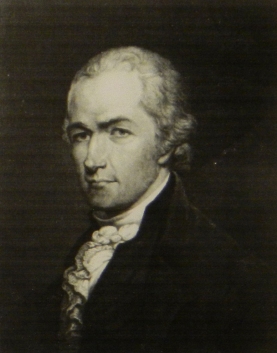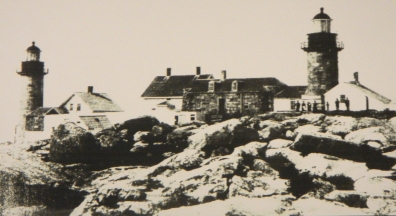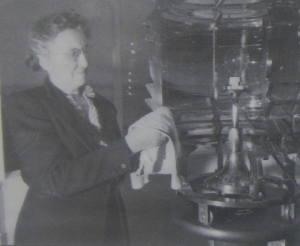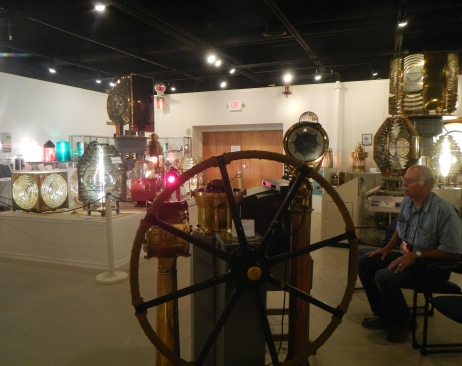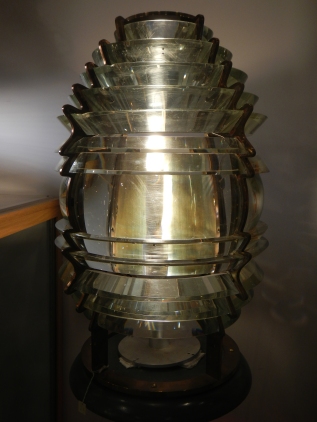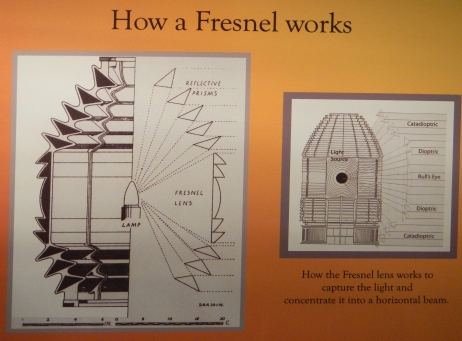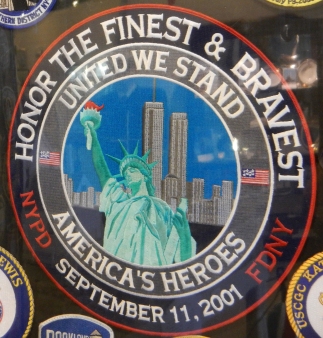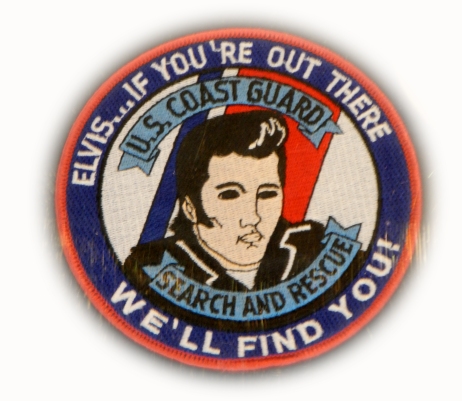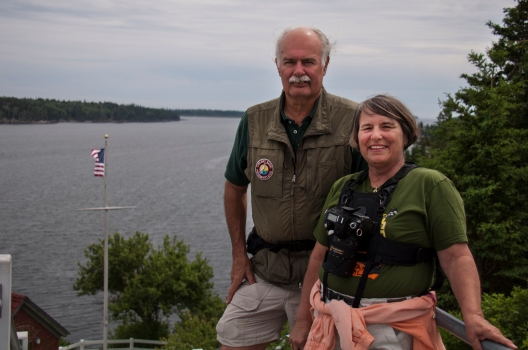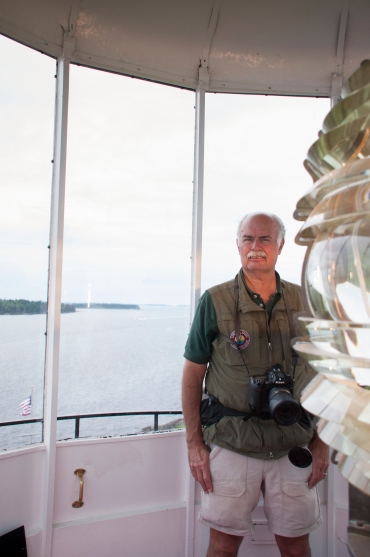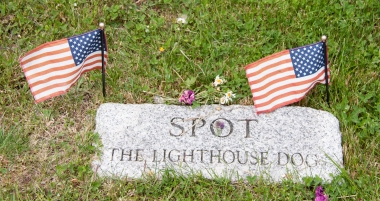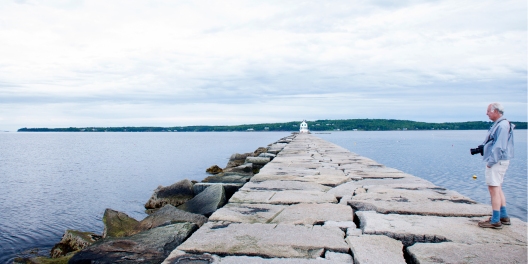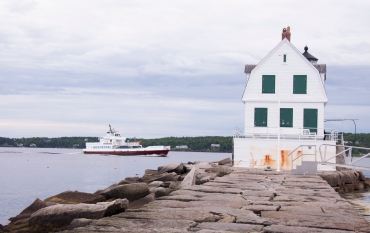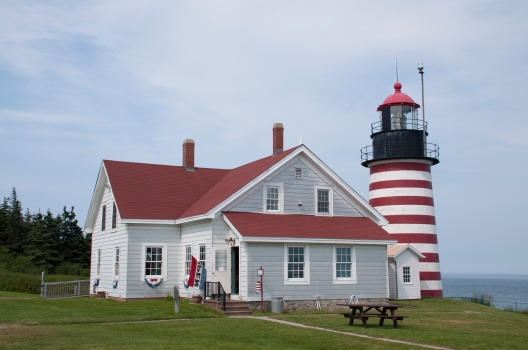Nothing indicates the Liberality, Prosperity or Intelligence of a nation more clearly than the facilities it affords for the Safe Approach of the Mariner to its shores.
From the 1868 report of the United States Lighthouse Board
With its long maritime history and spectacular but rocky coast Maine offers lighthouse aficionados a rare treat. You can purchase a lighthouse passport book and attempt to collect stamps from all of the ones open to the public. Or perhaps join the annual Lighthouse race when hundreds of people dash along the coast to see all of them in one 24-hr period. We spent time at a much more leisurely pace at four lighthouses: Owls Head, Rockland Breakwater, Bass Harbor and West Quoddy Head.
A great place to start your lighthouse education is at the Maine Lighthouse Museum in Rockland. The museum consists of several rooms with exhibits and on demand videos. Whether your interest is in the technical and architectural area or in the stories of those who lived and worked at the light stations, you won’t be disappointed. Plan to spend at least 2 hours here. Of course we were there over four hours! Many people have worked very hard to preserve our coastal heritage but none more than Connie Scoville Small. She and her husband were lighthouse keepers along the New England coast from 1920-1948. In her ‘retirement’ years she gave hundreds of lectures, appeared on television and wrote newspaper articles all aimed at preserving lighthouses and a way of life that no longer exists. She wrote a book called The Lighthouse Keeper’s Wife.
The museum exhibits began with the history of the United States Lighthouse Establishment created by Congress when it federalized all lighthouses in 1789. The first man in charge of the service was Alexander Hamilton when he was our first Secretary of the Treasury. We were fascinated by the story of Stephen Pleasonton. Never heard of him? Neither had we. When you hear what he did you’ll wonder why. We’ve all heard about Dolly Madison saving George Washington’s portrait when the British burned the capital during the War of 1812. Stephen Pleasanton was auditor of the Treasury in 1814. Among his numerous duties was overseeing and staffing lighthouses. Under instructions from Secretary of State James Monroe who saw the British land in Maryland, Pleasanton and his staff sewed linen bags and filled them with important documents and books. The documents were taken by wagon to a mill in Georgetown for safekeeping. Then Pleasonton realized the mill was near a munitions depot and moved the documents a second time to a farmhouse in Leesburg, VA. He kept the documents secure while watching Washington burn on the horizon. Just what were these documents? The bags contained George Washington’s letter of resignation as General of the Continental Army, the original Declaration of Independence, The Constitution of the United States and The Bill of Rights. Throughout his 32 year civil service career Pleasonton was known as a “tight wad”. Eventually public outcry and congressional investigation put an end to his budgetary constraints. In 1852 a nine member U. S. Lighthouse Board was created to take over the operation of our lighthouses. The nation was divided into twelve lighthouse districts each with a Lighthouse inspector responsible for construction, operation and staffing of the navigational aids. The Board was proactive in construction and modernization of lighthouses. By 1860 Fresnel lenses had been installed in all lighthouses. The Lighthouse Board was dissolved in 1910 when the civilian run Lighthouse Service was created. Under the leadership of George Putnam the United States went from sixth place in navigational safety to second place, surpassed only by the Netherlands. In 1939 the Coast Guard assumed responsibility for lighthouse operation by merging with the U. S. Lighthouse Service.
Another place where lighthouse history could have changed the world was when William Rosecrans was asked to be Abraham Lincoln’s second term Vice President. Besides a military career Rosecrans had invented the odorless oil lamp used in many lighthouses. Rosecrans took an extended time to accept the offer. Lincoln thought the delay was Rosecrans way of declining and then asked Andrew Johnson to be his running mate. Had Rosecrans answered in a timely fashion, he would have been President after Lincoln’s assassination.
There were stories about several women who made significant contributions to lighthouse history. One of the most widely publicized is that of 14 year-old Abbie Burgess when her family manned the remote Manticus Rock lighthouse in the Fall of 1856. The supply ship had not arrived on schedule and by December stores were at a critical level. Her father left to row the five miles to Manticus Island. A severe storm developed. Abbie moved her ailing mother and sisters from the wooden house to a granite building only minutes before the home was flooded. Then she scrambled along the rocks to rescue her pet chickens. The storm raged for twenty days. Abbie kept the lights burning in the lighthouse, rationed supplies of one cup of cornmeal and one egg to each of her family members. The story ended happily with all surviving and her father’s safe return. Two books that might be of interest are The Original Biography of Abbie Burgess, Lighthouse Heroine or a children’s book Keep The Lights Burning Abbie. Three years later her father was replaced by another lighthouse keeper but Abbie stayed on to assist with the transition. She fell in love with the new keeper’s son and was married in 1861. Except for a short period when they tried ‘civilian’ life the couple served in the Lighthouse Service. Abbie died just before her 54th birthday and is buried at Forest Hill Cemetery in Spruce Head, Maine where her grave is marked with an aluminum replica of a lighthouse.
Stories are not limited to lighthouses in Maine. Barbara Mabrity became keeper of the Key West lighthouse in 1832 upon the death of her husband who’d been lighthouse keeper. She was one of the first women appointed to the Lighthouse Service. Later on it became common for widowed women to assume their husband’s position. In 1846 a severe storm destroyed the lighthouse and all who sought shelter there including the six Mabrity children. Mrs. Mabrity resumed her duties in the new lighthouse in 1847 and remained until her retirement at age 82. Then there is Ida Lewis who at age 16 assumed lighthouse keeper duties at Lime Rock in Newport Harbor, Rhode Island when her father suffered a stroke. She performed many rescues and was the first woman to receive the Congressional Lifesaving Medal. Her fame spread and she received visits from President Grant, Susan B. Anthony and Mrs. William Astor. Andrew Carnegie became concerned over her lack of funds for her later years and set up a retirement fund. The first Coast Guard bouy tender was named after her. The next time you think you’ve had a hard day at the office, think about Katherine Walker who at 4’10” and 100 lbs. assumed keeper duties at Robbins Reef Light in New York Harbor when her husband died. She performed over fifty rescues, operated the fog bell and lantern as well as rowing her children to and from school in Bayonne, New Jersey. Life at a light station was not always bleak as shown by Emily Fish at Point Pinos Light in Pacific Grove, CA. She became keeper at age 50 after being widowed but continued to decorate and entertain with style using antiques, paintings and fine china. This earned her the title of “The Socialite Keeper”. The last civilian woman lighthouse keeper was Fannie Mae Salter at Turkey Point, MD. She served from 1925-1947.
On the more technical side the museum has displays showing the four types of marine light alerts; lighthouses, lightships, beacons and lighted buoys. Lighthouses were constructed from wood, cast iron, rubble stone, dressed granite and brick depending on the location. A 55-page manual listed the keeper’s duties beginning with the instruction “to be conversant with all apparatus.” This was closely followed with the admonition that “Ignorance upon any point will not be considered as a reason for neglect of duty.” Keepers stood watches of 12 hours at night to make sure the lights operated properly. If weather conditions required it a foghorn was sounded manually and often required operation for several days at a time. The keeper was responsible for all medical care at the station until he could signal a passing ship for assistance. Children were home schooled through the elementary grades unless they were close enough to attend shore-based schools. In the later years children would live with friends or relatives off island to attend school. After 1918 the Lighthouse Service paid teachers to go to the larger stations or built one room schoolhouses. An extensive display of Fresnel lenses, clothing, rescue equipment and artifacts will keep the technology oriented visitor interested. Lighthouses are used as symbols by many organizations. A display of badges and patches using lighthouses was on display. One shown here uses The Statue of Liberty, our most recognized lighthouse. There’s even a bit of roadside humor in the Elvis patch.
One of the last displays discussed lighthouses in other countries such as Canada, Great Britain, Russia and Japan. Japan has over 3300 lighthouses. The father and uncle of author Robert Louis Stevenson were lighthouse designers and builders in Scotland. They built the northernmost lighthouse in Great Britain, Muckle Flugga. This ties in with the Wyeth exhibit as N. C. Wyeth illustrated many of Stevenson’s books.
If you aren’t overdosed on seafaring history also plan a visit to the Penobscot Maritime Museum in Searsport, Maine. We stopped one Sunday afternoon not realizing the extent of the museum. We saw about half of the exhibits that are devoted to shipbuilding, trading and seamanship. We look forward to another longer visit when we come back.
Here are the four lighthouses we visited:
Owls Head lighthouse is located just south of Rockland at Owls Head State Park. This is a day use park with picnic facilities and a beach. The lighthouse is managed by the American Lighthouse Foundation and staffed by volunteers. Many of the properties under their umbrella were badly deteriorated with the USCG doing only operational and structurally required maintenance when ALF stepped in. By using the funds from tours and gift shops they have restored them to period condition. We went on a Saturday but I’m not sure about operating hours on weekdays. There is a nominal charge to enter the lighthouse but no fee for the grounds or small museum. This is one of the few lighthouses that has an original Fresnel lens. Most of them have been broken or ceased working and were replaced with a plastic lens. Unlike lighthouses in the south that must be several stories tall for ships to see them, Owls Head is short and built on a rocky hill. This means an easy climb to the top. While there we met a couple from New Hampshire who asked us to take their picture and then reciprocated by taking ours. Later we met again at the beach. We sat and talked for an hour finding many things in common. They had their RV at Camden Hills too so we continued our conversation at our site that evening. We hope to meet them at a New Hampshire State Park in September on our return loop.
Rockland Breakwater Lighthouse is at the end of a granite barrier in a city park. The Breakwater is almost a mile long, seven stories high and is constructed entirely of granite (700,000 tons that is). It was constructed between 1881 and 1902. You really have to see it to appreciate the size of the blocks of granite. The closest thing I’d seen were the huge blocks used at the Pyramids in Giza. As you walk along the breakwater you must watch the uneven surface and the 6-12” cracks between the blocks. There is a campaign running between June and September 2013 to make this the 8th Wonder of the World. The lighthouse wasn’t open when we were there in the evening. We did see some shorebirds and our first eider duck. On the way back I’d put my camera in my backpack. Apparently I’d forgotten to zip one half. All of a sudden the camera fell onto the stone. Could I have picked a grassy spot…no. I held my breath as I picked it up. The polarizer was smashed but my new 18-300mm lens appeared OK. The camera worked. Yes, I did deserve the HOW COULD I BE SO STUPID AWARD that day. I think Nikon should use this like Samsonite used the gorilla to demonstrate the durability of their product.
While we were in the Bar Harbor area we drove to Southwest Harbor to see the Bass Harbor lighthouse. It was a foggy afternoon but this gave us a different view of the lighthouse probably one similar to that of fishermen in the area. This lighthouse is not open to the public and access is only by scrambling along the rocks. Steve’s always much braver than I am about going out to the edge. As this was just before July 4th, there were lots of people crawling all over the rocks so getting a people free picture was a challenge.
The fourth Maine lighthouse we visited is West Quoddy Head. This is the easternmost lighthouse in the USA. So why is the easternmost lighthouse called West Quoddy Head, you ask? It’s because East Quoddy lighthouse is on Campbobello Island in New Brunswick, Canada. We saw that too and will cover it in an upcoming post. Quoddy Head State Park offers 5.5 miles trails through forest and bog down to the rocky shore. and an interesting museum. Here we learned that the body of XXX, father of the Coast Guard was buried until his body was exhumed and moved to New London in XXX. The red and white striped lighthouse built in 1808 has been painted with six or eight alternating stripes at various times. Right now there are eight. It was the first to use a fog bell and later a steam powered foghorn. The light was automated in 1988. Unfortunately the tower is not open. The view of Grand Manan Channel and Sail Rock is worth a visit by itself. The black cliffs are a type of rock called gabbro. You’ll hear more about this when we post our Catching Up #2 about Saugus Iron Works.


